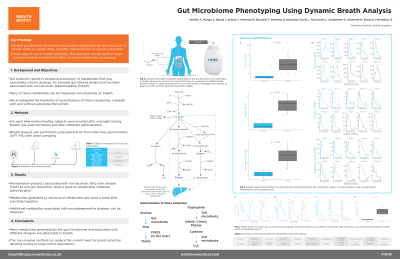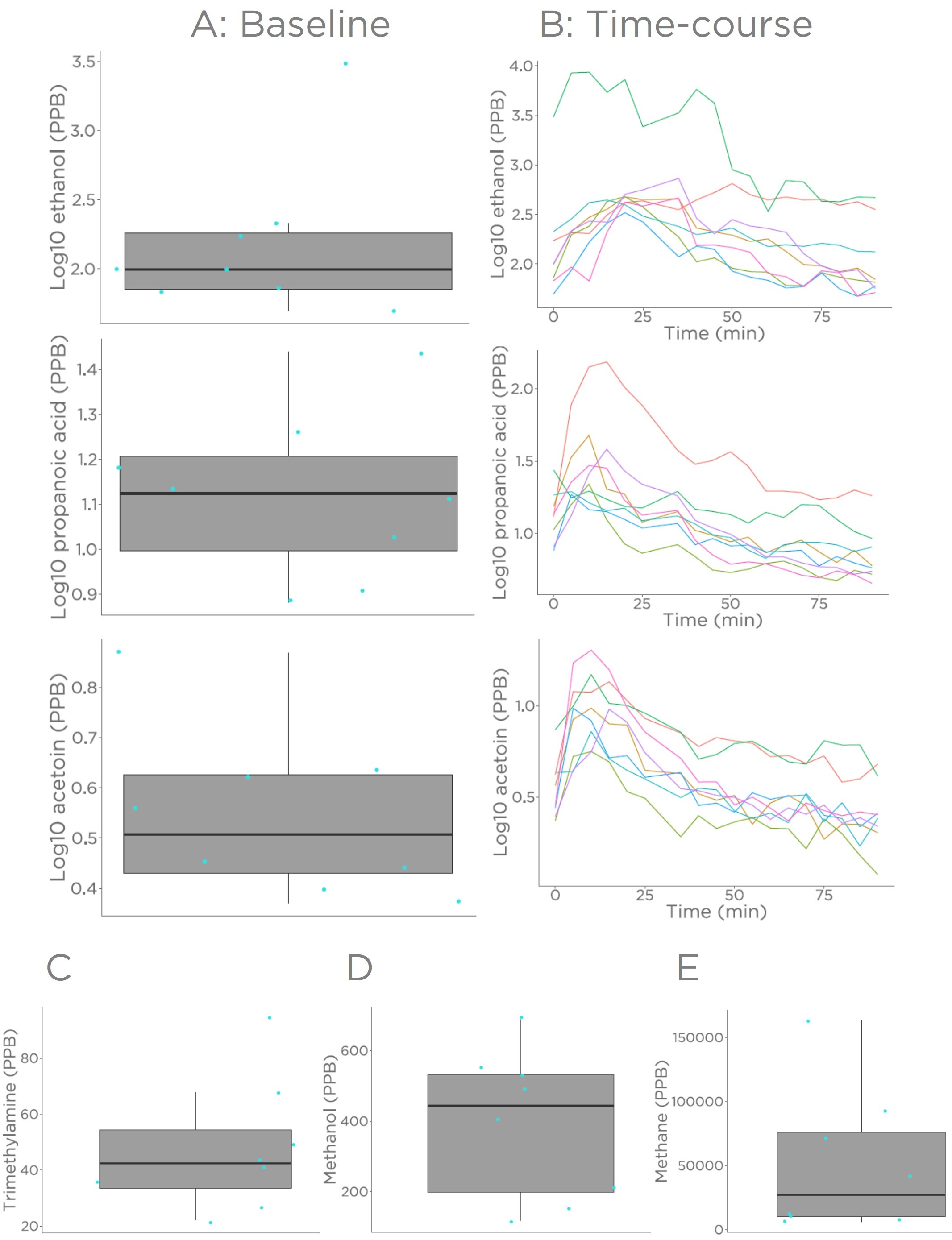Tuesday Poster Session
Category: Small Intestine
P4108 - Gut Bacteria Phenotyping Using Dynamic Breath Analysis
Tuesday, October 24, 2023
10:30 AM - 4:00 PM PT
Location: Exhibit Hall

Has Audio
- GF
Giuseppe Ferrandino
Owlstone Medical
Cambridge, England, United Kingdom
Presenting Author(s)
Ahmed Tawfike, , Antonio Murgia, , Iris Banda, , Yusuf Ahmed, , Menisha Manhota, , Federico Ricciardi, , Kelly Sweeney, , Louise Nicholson-Scott, BSc, Lucinda McConville, , Olga Gandelman, MBA, Max Allsworth, , Billy Boyle, , Giuseppe Ferrandino,
Owlstone Medical, Cambridge, England, United Kingdom
Introduction: Gut microbiota dysbiosis results in the overproduction of metabolites that exacerbate certain chronic diseases. For example, ethanol and 2-3-butanediol, produced by carbohydrate fermentation, were found associated with non-alcoholic steatohepatitis (NASH). Similarly, trimethylamine, produced from choline, is further metabolized in the liver to trimethylamine-N-oxide, a metabolite found associated with NASH severity and that exacerbates cardiovascular diseases. We explored the feasibility of a novel approach to measure gut bacteria metabolites, which can be applied to assess the extent of gut bacteria metabolism in disease populations.
Methods: A total of 8 healthy subjects were recruited with age ≥ 18 years and body weight ≥ 50 Kg. Subjects were instructed to fast overnight and to not drink alcoholic beverages the day before the experiments. Breath samples were collected before, and up to 90 minutes after ingestion of 75g of glucose with a time resolution of 5 minutes. Compounds of interest were measured using SIFT-MS with direct sampling. Results were expressed as part per billion (PPB v/v) as a function of time post-glucose ingestion.
Results: Ambient measurements showed that all the investigated compounds were absent before and after conducting the experiment. Median (M) and interquartile range (IQR) baselines levels (before glucose administration) of ethanol, propanoic acid, and acetoin (an intermediate of the 2-3-butanediol fermentation), were respectively 99.4 [71.6-182.4], 13.3 [10-16.2], 3.2 [2.7, 4.2] PPB (Fig.1A). Post glucose ingestion we observed spikes of these compounds in breath of up to respectively 8629, 153, and 20 PPB (Fig. 1B). Additional diseases associated compounds, unrelated to glucose ingestion, were also detected, such as trimethylamine (M: 42.3, IQR: 33.6-54.3 PPB) (Fig.1C), methanol (M: 443, IQR: 199-531.4 PPB) (Fig.1D), and methane (M: 26988, IQR: 10100-76213 PPB) (Fig.1E).
Discussion: Dynamic breath analysis can be used for the clinical characterization of gut bacteria metabolism in healthy and disease populations to establish correlations between metabolites and disease severity and progression, as well as the interaction of gut microbiota with response to therapeutic interventions. This non-invasive method can replace the current need for blood collection allowing scaling to large cohort populations.

Disclosures:
Ahmed Tawfike, , Antonio Murgia, , Iris Banda, , Yusuf Ahmed, , Menisha Manhota, , Federico Ricciardi, , Kelly Sweeney, , Louise Nicholson-Scott, BSc, Lucinda McConville, , Olga Gandelman, MBA, Max Allsworth, , Billy Boyle, , Giuseppe Ferrandino, . P4108 - Gut Bacteria Phenotyping Using Dynamic Breath Analysis, ACG 2023 Annual Scientific Meeting Abstracts. Vancouver, BC, Canada: American College of Gastroenterology.
Owlstone Medical, Cambridge, England, United Kingdom
Introduction: Gut microbiota dysbiosis results in the overproduction of metabolites that exacerbate certain chronic diseases. For example, ethanol and 2-3-butanediol, produced by carbohydrate fermentation, were found associated with non-alcoholic steatohepatitis (NASH). Similarly, trimethylamine, produced from choline, is further metabolized in the liver to trimethylamine-N-oxide, a metabolite found associated with NASH severity and that exacerbates cardiovascular diseases. We explored the feasibility of a novel approach to measure gut bacteria metabolites, which can be applied to assess the extent of gut bacteria metabolism in disease populations.
Methods: A total of 8 healthy subjects were recruited with age ≥ 18 years and body weight ≥ 50 Kg. Subjects were instructed to fast overnight and to not drink alcoholic beverages the day before the experiments. Breath samples were collected before, and up to 90 minutes after ingestion of 75g of glucose with a time resolution of 5 minutes. Compounds of interest were measured using SIFT-MS with direct sampling. Results were expressed as part per billion (PPB v/v) as a function of time post-glucose ingestion.
Results: Ambient measurements showed that all the investigated compounds were absent before and after conducting the experiment. Median (M) and interquartile range (IQR) baselines levels (before glucose administration) of ethanol, propanoic acid, and acetoin (an intermediate of the 2-3-butanediol fermentation), were respectively 99.4 [71.6-182.4], 13.3 [10-16.2], 3.2 [2.7, 4.2] PPB (Fig.1A). Post glucose ingestion we observed spikes of these compounds in breath of up to respectively 8629, 153, and 20 PPB (Fig. 1B). Additional diseases associated compounds, unrelated to glucose ingestion, were also detected, such as trimethylamine (M: 42.3, IQR: 33.6-54.3 PPB) (Fig.1C), methanol (M: 443, IQR: 199-531.4 PPB) (Fig.1D), and methane (M: 26988, IQR: 10100-76213 PPB) (Fig.1E).
Discussion: Dynamic breath analysis can be used for the clinical characterization of gut bacteria metabolism in healthy and disease populations to establish correlations between metabolites and disease severity and progression, as well as the interaction of gut microbiota with response to therapeutic interventions. This non-invasive method can replace the current need for blood collection allowing scaling to large cohort populations.

Figure: Fig. 1
Disclosures:
Ahmed Tawfike: Owlstone Medical – Employee.
Antonio Murgia: Owlstone Medical – Employee. Owlstone Medical – Employee.
Iris Banda: Owlstone Medical – Employee.
Yusuf Ahmed: Owlstone Medical – Employee.
Menisha Manhota: Owlstone Medical – Employee.
Federico Ricciardi: Owlstone Medical – Employee.
Kelly Sweeney: Owlstone Medical – Employee.
Louise Nicholson-Scott: Owlstone Medical – Employee.
Lucinda McConville: Owlstone Medical – Employee.
Olga Gandelman: Owlstone Medical – Employee.
Max Allsworth: Owlstone Medical – Employee.
Billy Boyle: Owlstone Medical – Employee.
Giuseppe Ferrandino: Owlstone Medical – Employee.
Ahmed Tawfike, , Antonio Murgia, , Iris Banda, , Yusuf Ahmed, , Menisha Manhota, , Federico Ricciardi, , Kelly Sweeney, , Louise Nicholson-Scott, BSc, Lucinda McConville, , Olga Gandelman, MBA, Max Allsworth, , Billy Boyle, , Giuseppe Ferrandino, . P4108 - Gut Bacteria Phenotyping Using Dynamic Breath Analysis, ACG 2023 Annual Scientific Meeting Abstracts. Vancouver, BC, Canada: American College of Gastroenterology.

